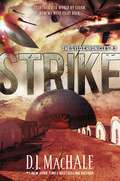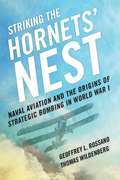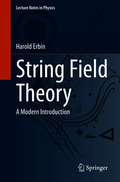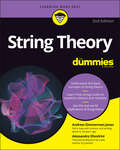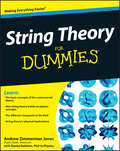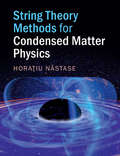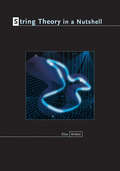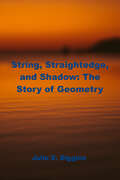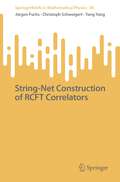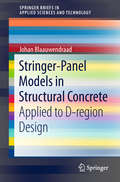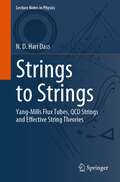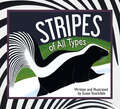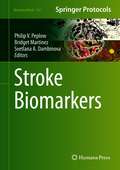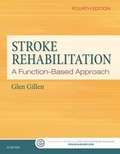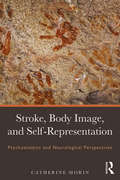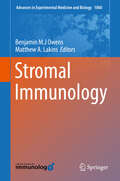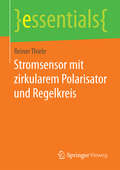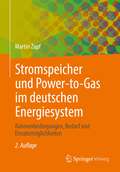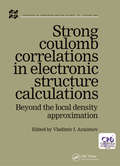- Table View
- List View
Strike: The SYLO Chronicles #3 (The SYLO Chronicles #3)
by D. J. MacHale#1 New York Times bestselling author D.J. MacHale is back with the third book in the SYLO Chronicles. Once again, Tucker Pierce and friends must fight for their lives against the better-equipped SYLO. All bets are off in Strike--with twists so big readers will never see them coming--while the action and pulse-pounding suspense remain as high as ever. Fans will be sure to devour this incredibly satisfying conclusion.Praise for the SYLO Chronicles: "A relentlessly fast-paced, intriguing, expertly-written tale that leaves you breathless and satisfied, yet wanting more. Highly recommended."--James Dashner, New York Times bestselling author of the Maze Runner series "Absolutely un-put-downable, more exciting than an Xbox and roller coaster combined."--Kirkus, starred review"If you're a fan of The Maze Runner and Alex Rider, you might want to pick up SYLO. . . . A fast-paced read and a huge cliffhanger."--EW.com"With this extremely high-octane story that's the equivalent to a summer movie blockbuster, MacHale kicks off an apocalyptic trilogy sure to leave readers demanding the next installment."--Booklist"This action-filled, end-of-the-world-as-we-know-it adventure . . . should leave teen readers clamoring for the next installment."--VOYA"An entertaining and creepy tale."--Publishers Weekly"MacHale pens some terrific and unique action scenes. . . will leave readers hungry for the next installment."--School Library Journal
Striking The Hornets' Nest: Naval Aviation And The Origins Of Strategic Bombing In World War I
by Thomas Wildenberg Geoffrey L. RossanoStriking the Hornets’ Nest provides the first extensive analysis of the Northern Bombing Group (NBG), the Navy’s most innovative aviation initiative of World War I and one of the world’s first dedicated strategic bombing programs. Very little has been written about the Navy’s aviation activities in World War I and even less on the NBG. Standard studies of strategic bombing tend to focus on developments in the Royal Air Force or the U. S. Army Air Service. This work concentrates on the origins of strategic bombing in World War I, and the influence this phenomenon had on the Navy’s future use of the airplane. The NBG program faced enormous logistical and personnel challenges. Demands for aircraft, facilities, and personnel were daunting, and shipping shortages added to the seemingly endless delays in implementing the program. Despite the impediments, the Navy (and Marine Corps) triumphed over organizational hurdles and established a series of bases and depots in northern France and southern England in the late summer and early fall of 1918. Ironically, by the time the Navy was ready to commence bombing missions, the German retreat had caused abandonment of the submarine bases the NBG had been created to attack. The men involved in this program were pioneers, overcoming major obstacles only to find they were no longer needed. Though the Navy rapidly abandoned its use of strategic bombing after World War I, their brief experimentation directed the future use of aircraft in other branches of the armed forces. It is no coincidence that Robert Lovett, the young Navy reserve officer who developed much of the NBG program in 1918, spent the entire period of World War II as Assistant Secretary of War for Air where he played a crucial role organizing and equipping the strategic bombing campaign unleashed against Germany and Japan. Rossano and Wildenberg have provided a definitive study of the NBG, a subject that has been overlooked for too long.
String Field Theory: A Modern Introduction (Lecture Notes in Physics #980)
by Harold ErbinThis textbook provides an introduction to string field theory (SFT). String theory is usually formulated in the worldsheet formalism, which describes a single string (first-quantization). While this approach is intuitive and could be pushed far due to the exceptional properties of two-dimensional theories, it becomes cumbersome for some questions or even fails at a more fundamental level. These motivations have led to the development of SFT, a description of string theory using the field theory formalism (second-quantization). As a field theory, SFT provides a rigorous and constructive formulation of string theory. The main focus of the book is the construction of the closed bosonic SFT. The accent is put on providing the reader with the foundations, conceptual understanding and intuition of what SFT is. After reading this book, the reader is able to study the applications from the literature. The book is organized in two parts. The first part reviews the notions of the worldsheet theory that are necessary to build SFT (worldsheet path integral, CFT and BRST quantization). The second part starts by introducing general concepts of SFT from the BRST quantization. Then, it introduces off-shell string amplitudes before providing a Feynman diagrams interpretation from which the building blocks of SFT are extracted. After constructing the closed SFT, the author outlines the proofs of several important properties such as background independence, unitarity and crossing symmetry. Finally, the generalization to the superstring is also discussed.
String Theory
by Joseph PolchinskiString Theory, first published in 1998, comprises two volumes which provide a comprehensive and pedagogic account of the subject. Volume 2 begins with an introduction to supersymmetric string theories and presents the important advances of recent years. The first three chapters introduce the type I, type II, and heterototic superstring theories and their interactions. The next two chapters present important recent discoveries about strongly coupled strings, beginning with a detailed treatment of D-branes and their dynamics, and covering string duality, M-theory, and black hole entropy. The final chapters are concerned with four-dimensional string theories, showing how some of the simplest string models connect with previous ideas for unifying the Standard Model. They collect many important results on world-sheet and spacetime symmetries. An appendix summarizes the necessary background on fermions and supersymmetry. An essential text and reference for graduate students and researchers interested in superstring theory.
String Theory For Dummies
by Andrew Zimmerman Jones Alessandro SfondriniUnravel the secrets of the universe and untangle cutting-edge physics Yes, you actually can understand quantum physics! String Theory For Dummies is a beginner’s guide, and we make it fun to find out about the all the recent trends and theories in physics, including the basics of string theory, with friendly explanations. Build a foundation of physics knowledge, understand the various string theories and the math behind them, and hear what the opponents to string theory have to say. It’s an exciting time to be alive in advanced physics, and this updated edition covers what’s new in the string world—the Large Hadron Collider, the Higgs Boson, gravitational waves, and lots of other big headlines. Unleash your inner armchair physicist with String Theory For Dummies. Brush up on the basics of physics and the approachable math needed to understand string theory Meet the scientists who discovered string theory and continue to make waves (and particles) in the physics world Understand what it’s all about with real-world examples and explanations Learn why string theory is called "The Theory of Everything"—and what it means for technology and the future Aspiring scientists or life-long learners will both be able to gain valuable information from this book. This accessible intro into string theory is for the theorists inside anyone.
String Theory For Dummies
by Daniel Robbins Andrew Zimmerman JonesLearn:The basic concepts of this controversial theoryHow string theory builds on physics conceptsThe different viewpoints in the fieldString theory's physical implicationsYour plain-English guide to this complex scientific theoryString theory is one of the most complicated sciences being explored today. Not to worry though! This informative guide clearly explains the basics of this hot topic, discusses the theory's hypotheses and predictions, and explores its curious implications. It also presents the critical viewpoints in opposition to string theory so you can draw your own conclusions.Understand the "theory of everything" -- grasp the key concepts and importance of the theory, and learn why scientists are so excited about finding a theory of quantum gravityIt all comes down to physics -- discover how string theory is built upon the major scientific developments of the early 20th centuryBuilding the theory -- trace the creation and development of string theory, discover its predictions, and see whether accurate conclusions can be madeTake string theory for a spin -- explore the core issue of extra dimensions, the implications for cosmology, and how string theory could explain certain properties of our universeBoldly go where no one has gone -- see what string theory has to say about possible parallel universes, the origin and fate of our universe, and the potential for time travelHear from the critics -- listen in on the heated debates about string theory and weigh the alternatives being offeredOpen the book and find:The questions string theory attempts to answerEasy-to-follow examplesExplanations of Einstein's theory of relativity, quantum theory, and particle physicsThe successes and failures of string theoryFascinating bits of string theory including strings and branesWays that string theory can be testedDiscussions of loop quantum gravity and other possible alternative theories of gravityHow the theory may relate to cosmic mysteries, from the origin of matter to black holes
String Theory Methods for Condensed Matter Physics
by Horaţiu NăstaseThe discovery of a duality between Anti-de Sitter spaces (AdS) and Conformal Field Theories (CFT) has led to major advances in our understanding of quantum field theory and quantum gravity. String theory methods and AdS/CFT correspondence maps provide new ways to think about difficult condensed matter problems. String theory methods based on the AdS/CFT correspondence allow us to transform problems so they have weak interactions and can be solved more easily. They can also help map problems to different descriptions, for instance mapping the description of a fluid using the Navier–Stokes equations to the description of an event horizon of a black hole using Einstein's equations. This textbook covers the applications of string theory methods and the mathematics of AdS/CFT to areas of condensed matter physics. Bridging the gap between string theory and condensed matter, this is a valuable textbook for students and researchers in both fields. The applications of string theory methods to condensed matter physics is a topical subject, and readers will gain understanding of both fields. No background knowledge is assumed so readers can come at the topic from different physics backgrounds. Gives an overview of most string theory methods used for condensed matter, enabling the reader to start research in the area whether their background is in string theory or condensed matter.
String Theory Volume I
by Joseph PolchinskiThe two volumes that comprise String Theory provide an up-to-date, comprehensive account of string theory. Volume 1 provides a thorough introduction to the bosonic string, based on the Polyakov path integral and conformal field theory. The first four chapters introduce the central ideas of string theory, the tools of conformal field theory, the Polyakov path integral, and the covariant quantization of the string. The book then treats string interactions: the general formalism, and detailed treatments of the tree level and one loop amplitudes. Toroidal compactification and many important aspects of string physics, such as T-duality and D-branes are also covered, as are higher-order amplitudes, including an analysis of their finiteness and unitarity, and various nonperturbative ideas. The volume closes with an appendix giving a short course on path integral methods, followed by annotated references, and a detailed glossary.
String Theory and M-Theory: A Modern Introduction
by Katrin Becker Melanie Becker John H. SchwarzString theory is one of the most exciting and challenging areas of modern theoretical physics. This book guides the reader from the basics of string theory to recent developments. It introduces the basics of perturbative string theory, world-sheet supersymmetry, space-time supersymmetry, conformal field theory and the heterotic string, before describing modern developments, including D-branes, string dualities and M-theory. It then covers string geometry and flux compactifications, applications to cosmology and particle physics, black holes in string theory and M-theory, and the microscopic origin of black-hole entropy. It concludes with Matrix theory, the AdS/CFT duality and its generalizations. This book is ideal for graduate students and researchers in modern string theory, and will make an excellent textbook for a one-year course on string theory. It contains over 120 exercises with solutions, and over 200 homework problems with solutions available on a password protected website for lecturers at www. cambridge. org/9780521860697.
String Theory and Particle Physics
by Luis E. Ibáñez Angel M. UrangaString theory is one of the most active branches of theoretical physics and has the potential to provide a unified description of all known particles and interactions. This book is a systematic introduction to the subject, focused on the detailed description of how string theory is connected to the real world of particle physics. Aimed at graduate students and researchers working in high energy physics, it provides explicit models of physics beyond the Standard Model. No prior knowledge of string theory is required as all necessary material is provided in the introductory chapters. The book provides particle phenomenologists with the information needed to understand string theory model building and describes in detail several alternative approaches to model building, such as heterotic string compactifications, intersecting D-brane models, D-branes at singularities and F-theory.
String Theory and the Scientific Method
by Richard DawidString theory has played a highly influential role in theoretical physics for nearly three decades and has substantially altered our view of the elementary building principles of the Universe. However, the theory remains empirically unconfirmed, and is expected to remain so for the foreseeable future. So why do string theorists have such a strong belief in their theory? This book explores this question, offering a novel insight into the nature of theory assessment itself. Dawid approaches the topic from a unique position, having extensive experience in both philosophy and high-energy physics. He argues that string theory is just the most conspicuous example of a number of theories in high-energy physics where non-empirical theory assessment has an important part to play. Aimed at physicists and philosophers of science, the book does not use mathematical formalism and explains most technical terms.
String Theory in a Nutshell
by Elias KiritsisThis book is the essential new introduction to modern string theory, by one of the world's authorities on the subject. Concise, clearly presented, and up-to-date, String Theory in a Nutshell brings together the best understood and most important aspects of a theory that has been evolving since the early 1980s. A core model of physics that substitutes one-dimensional extended "strings" for zero-dimensional point-like particles (as in quantum field theory), string theory has been the leading candidate for a theory that would successfully unify all fundamental forces of nature, including gravity.Starting with the basic definitions of the theory, Elias Kiritsis guides readers through classic and modern topics. In particular, he treats perturbative string theory and its Conformal Field Theory (CFT) tools in detail while also developing nonperturbative aspects and exploring the unity of string interactions. He presents recent topics including black holes, their microscopic entropy, and the AdS/CFT correspondence. He also describes matrix model tools for string theory. In all, the book contains nearly five hundred exercises for the graduate-level student, and works as a self-contained and detailed guide to the literature.String Theory in a Nutshell is the staple one-volume reference on the subject not only for students and researchers of theoretical high-energy physics, but also for mathematicians and physicists specializing in theoretical cosmology and QCD.
String, Straightedge, and Shadow: The Story of Geometry
by Julia E. DigginsThis book explains how the basic principles of elementary geometry were discovered over 2,000 years ago. Indicates the major roles played by the early civilizations of Mesopotamia, Egypt, and Greece.
String-Net Construction of RCFT Correlators (SpringerBriefs in Mathematical Physics #45)
by Yang Yang Jürgen Fuchs Christoph SchweigertThis book studies using string-net models to accomplish a direct, purely two-dimensional, approach to correlators of two-dimensional rational conformal field theories. The authors obtain concise geometric expressions for the objects describing bulk and boundary fields in terms of idempotents in the cylinder category of the underlying modular fusion category, comprising more general classes of fields than is standard in the literature. Combining these idempotents with Frobenius graphs on the world sheet yields string nets that form a consistent system of correlators, i.e. a system of invariants under appropriate mapping class groups that are compatible with factorization. The authors extract operator products of field objects from specific correlators; the resulting operator products are natural algebraic expressions that make sense beyond semisimplicity. They also derive an Eckmann-Hilton relation internal to a braided category, thereby demonstrating the utility of string nets for understanding algebra in braided tensor categories. Finally, they introduce the notion of a universal correlator. This systematizes the treatment of situations in which different world sheets have the same correlator and allows for the definition of a more comprehensive mapping class group.
Stringer-Panel Models in Structural Concrete: Applied to D-region Design (SpringerBriefs in Applied Sciences and Technology)
by Johan BlaauwendraadStructural concrete designers nowadays distinguish between B-regions (named after Bernoulli beam theory) and D-regions (D standing for ‘disturbed’). They are all familiar with B-regions, but less acquainted with the expertise required for D-regions. To design D-regions, the Strut-and-Tie Model (STM) is usually applied, a model laid down worldwide in structural codes of practice. The Stringer-Panel Model (SPM) recommended here is a companion method to the STM, with the advantage of being suitable for different load cases and reversed loading. This being so, the SPM is suitable for linear-elastic analyses where durability is a key consideration, but also suits structural design for contexts of cyclical seismic activity. Finally, this book sets out how structural engineers who prefer the STM can nevertheless apply the SPM to determine a proper strut-and-tie model.
Strings to Strings: Yang-Mills Flux Tubes, QCD Strings and Effective String Theories (Lecture Notes in Physics #1018)
by N. D. Hari DassThis book presents the essentials culminating in the effective string theory of flux tubes in meticulous technical and conceptual detail. The book is divided into four parts. Part One provides historical background, while Part Two (consisting of 14 chapters) covers the passage from Heisenberg's S-matrix theory to String Theory. This includes non-perturbative LSZ formalism, dispersion relations, Regge poles, duality and dual resonance models. Part Three offers a comprehensive analysis of QCD, focusing on important concepts like asymptotic freedom and quark confinement. The section also delves into lattice gauge theories and effective descriptions of superconductivity and strong interactions. Part Four, the final two chapters, describe the lattice gauge theory determinations of Yang-Mills flux tubes in three and four dimensions and effective string theories, including their systematic constructions. These chapters provide detailed technical information to help readers, especially students, develop their expertise in these ideas. This book is ideal for graduate students, postdocs, and senior researchers looking to deepen their understanding of effective string theory and related concepts.
Stripes of All Types
by Susan StockdaleA patterned parade of animals comes to life! What kinds of animals have stripes and why do they have them? With engaging rhymes and bright, bold images, award-winning author-illustrator Susan Stockdale introduces readers to a range of striped animals, familiar and exotic, and some of the benefits of their patterns. In addition to providing beauty and inspiration, stripes can help a creature communicate with and recognize fellow members of its species, provide camouflage for hunting or hiding, or confuse or scare off predators. From the tiger to the Malaysia tapir, the ring-tailed lemur to the zebra, these stunning striped creatures will delight and fascinate budding naturalists. This entrancing companion to Spectacular Spots features energetic rhyming text and beautifully detailed paintings that pop off the page. An afterword tells a little bit more about each animal and where it lives, and readers can test their knowledge of animal stripes with a fun matching game at the end.
Stroke Biomarkers (Neuromethods #147)
by Philip V. Peplow Bridget Martinez Svetlana A. DambinovaThis volume presents the latest data on recent achievements in new and emerging technologies for stroke biomarkers and innovations in stroke assessment. The topics discussed in this book explore the role of upcoming biomarkers in different types of stroke, and explores techniques that will allow researchers to be more effective when approaching clinical management and patient care. In Neuromethods series style, chapters include the kind of detail and key advice from the specialists needed to ensure successful results in the laboratory.Cutting-edge and comprehensive, Stroke Biomarkers is a valuable resource for both experimental and clinical scientists interested in expanding their knowledge in the field of stroke research.
Stroke Rehabilitation: A Function-based Approach (Fourth Edition)
by Glen GillenThe fourth edition of Stroke Rehabilitation: A Function-Based Approach continues to strive to be the most up-to-date text on this topic, incorporating state-of-the-art and evidence-based tools and techniques to maximize function and quality of life for those living with stroke. This edition's contributors include expert clinicians, researchers, and scientists from across the globe. Contributors are experts in various disciplines, including neurology, occupational therapy, physiatry, physical therapy, psychology, and speech and language pathology.
Stroke Revisited: Vascular Cognitive Impairment (Stroke Revisited)
by Seung-Hoon Lee Jae-Sung LimThis book presents state of the art knowledge on vascular cognitive impairment (VCI). The focus is in particular on two major representative clinical syndromes of VCI: subcortical VCI and post-stroke cognitive impairment. Individual chapters address a wide range of topics and issues, providing up-to-date information on epidemiology, cognitive evaluation, pathophysiology, established and emerging neuroimaging biomarkers, amyloid imaging, serum and genetic biomarkers, prognosis, prevention, and treatment. The accompanying illustrations and photos enable the reader to achieve a ready understanding of the contents and to retrieve fundamental information quickly. The book will be an invaluable resource for stroke physicians, surgeons, and students wishing to learn more about the latest advances, from efforts to harmonize neuropsychological evaluation and improvements in diagnostic criteria through to the role of advanced neuroimaging techniques in deepening understanding of VCI and progress toward more targeted treatment.
Stroke, Body Image, and Self Representation: Psychoanalytic and Neurological Perspectives
by Catherine MorinStroke, Body Image, and Self Representation provides a psychoanalytic reading of the subjective difficulties encountered by patients who have suffered a stroke. The book is based on the words of stroke patients and on their self-portraits, which are then compared with the words and portraits of subjects devoid of brain lesions. Pathological and normal self-portraits illustrate in very concrete terms the libidinal investment of our body parts. The author's original data sheds an entirely new light on the subjective effects of a stroke. On the one hand, the permanent sequelae of a stroke can cause a narcissistic injury; on the other, a stroke may affect the brain circuitry involved in the patient's body image, undoing the normal narcissistic reactions. This may happen after right hemisphere lesions and cause spectacular symptoms, such as the personification of a paralyzed hand or the apparent ignorance of a severe paralysis. This double aspect of a stroke is no small problem for rehabilitation therapists, who must avoid two pitfalls: considering any issue as psychological in nature, as if the brain lesion could not produce any organic changes, or, on the contrary, attributing any behavioural problems to brain dysfunction, as if the patient was devoid of normal psychological reactions. One of the aims of this book is to help therapists gaining their bearings in this little-known field. In addition to this clinical interest, the author's psychoanalytic reading brings an original contribution to the physiopathology of cognition and self-representation. The data gathered by Catherine Morin show that self-representation cannot be considered only a cognitive operation. They also suggest that normal cognitive activity relies on both the stability of body image and the repression of the object. Stroke, Body Image, and Self Representation will appeal to psychoanalysts, psychologists, social workers, psychotherapists, psychiatrists, and rehabilitation therapists working with stroke survivors and patients with body image disorders.
Stromal Immunology (Advances in Experimental Medicine and Biology #1060)
by Benjamin M.J Owens Matthew A. LakinsResearch into and interest in the role of stromal cells in immunology has exploded over the past 15 years. The conventional view that placed non-hematopoietic stromal cells as passive, structural, and supportive entities has now been replaced with an appreciation that these cells have active, dynamic roles during immune responses, and thus impact on the pathophysiology of multiple immune-mediated diseases. This book serves to provide solid grounding in the fundamentals of stromal immunology, focusing on the biological aspects of their function in addition to highlighting key areas for the development of the field in the future. The book is also a unique source of information on emerging concepts that place stromal cells from outside lymphoid organs as major contributors to the biology of diverse conditions, such as rheumatoid arthritis, chronic parasitic infection, inflammatory bowel disease, and cancer.
Stromsensor mit zirkularem Polarisator und Regelkreis (essentials)
by Reiner ThieleReiner Thiele bearbeitet ein grunds#65533;tzliches Problem der Messtechnik: die potenzialgetrennte Messung elektrischer Str#65533;me ohne Eingriff in den Stromkreis der Messgr#65533;#65533;e. Die L#65533;sung ist die Schaltungsanordnung eines reflektierenden Stromsensors zur Messung elektrischer Str#65533;me mit automatischer Kompensation der Doppelbrechung und streng linearer Beziehung zwischen Messwerten und -gr#65533;#65533;e. Wiederholt gelang dem Autor mit dieser Erfindung die exakte L#65533;sung einer nichtlinearen Differenzialgleichung (DGL), die diese Schaltungsanordnung beschreibt. Au#65533;erdem appliziert er einen rechts- oder linksdrehenden zirkularen Polarisator zur messgr#65533;#65533;enabh#65533;ngigen Ver#65533;nderung der transversalen Komponente einer elektrischen Verschiebungsflussdichte in den Sensor-Lichtwellenleitern (LWL).
Stromspeicher und Power-to-Gas im deutschen Energiesystem: Rahmenbedingungen, Bedarf und Einsatzmöglichkeiten
by Martin ZapfDieses Fachbuch gibt Aufschluss über die Grundzüge des deutschen Stromsystems und geht auf aktuelle Entwicklungen ein. Unter Berücksichtigung zahlreicher beeinflussender Faktoren und eines Literaturreviews wird der Stromspeicherbedarf in Deutschland abgeschätzt und zusammen mit Berechnungen zu Stromspeicherkosten ausgewählte Technologien beurteilt. In diesem Rahmen wird die aktuelle Gesetzeslage sowie die Netzdienlichkeit bzw. Netzverträglichkeit von Stromspeichern beleuchtet. Power-to-Gas inkl. der vorhandenen Erdgasinfrastruktur ist ein eigenes Kapitel gewidmet. Letztlich werden die Potenziale synthetischer Gase im Verkehrsektor aufgezeigt sowie die Erdgas- und Elektromobilität gegenübergestellt.
Strong Coulomb Correlations in Electronic Structure Calculations (Advances in Condensed Matter Science)
by Vladimir I. AnisimovMaterials where electrons show nearly localized rather than itinerant behaviour, such as the high-temperature superconducting copper oxides, or manganate oxides, are attracting interest due to their physical properties and potential applications. For these materials, the interaction between electrons, or electron correlation, plays an important rol
